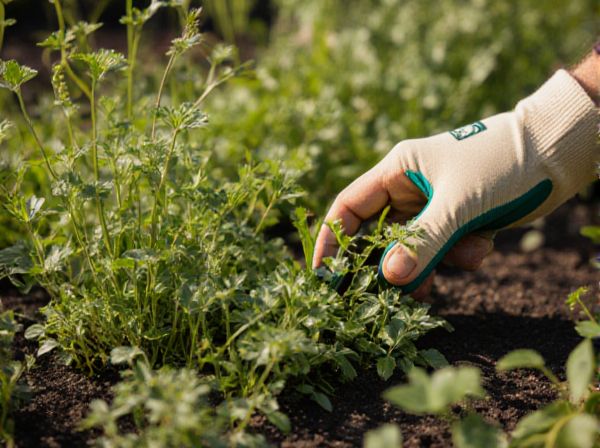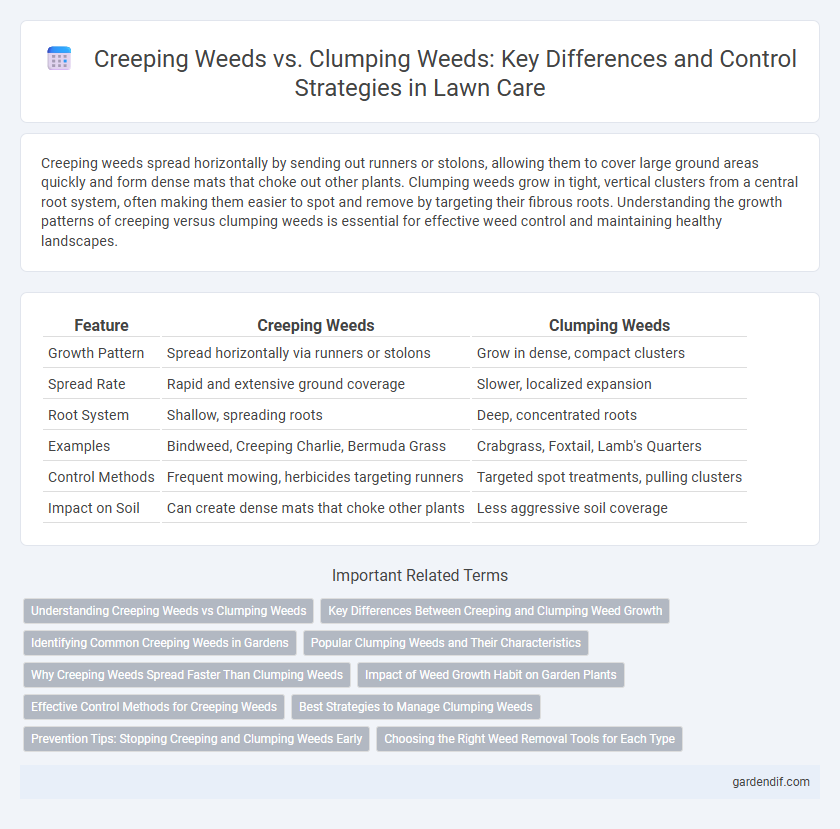
Creeping weeds vs clumping weeds Illustration
Creeping weeds spread horizontally by sending out runners or stolons, allowing them to cover large ground areas quickly and form dense mats that choke out other plants. Clumping weeds grow in tight, vertical clusters from a central root system, often making them easier to spot and remove by targeting their fibrous roots. Understanding the growth patterns of creeping versus clumping weeds is essential for effective weed control and maintaining healthy landscapes.
Table of Comparison
| Feature | Creeping Weeds | Clumping Weeds |
|---|---|---|
| Growth Pattern | Spread horizontally via runners or stolons | Grow in dense, compact clusters |
| Spread Rate | Rapid and extensive ground coverage | Slower, localized expansion |
| Root System | Shallow, spreading roots | Deep, concentrated roots |
| Examples | Bindweed, Creeping Charlie, Bermuda Grass | Crabgrass, Foxtail, Lamb's Quarters |
| Control Methods | Frequent mowing, herbicides targeting runners | Targeted spot treatments, pulling clusters |
| Impact on Soil | Can create dense mats that choke other plants | Less aggressive soil coverage |
Understanding Creeping Weeds vs Clumping Weeds
Creeping weeds spread horizontally through runners or stolons, allowing them to cover large areas rapidly and invade new spaces, making control challenging. Clumping weeds grow in dense clusters or tufts, expanding primarily through root division, which confines their growth to localized spots. Understanding these growth patterns is crucial for selecting effective weed management strategies, such as targeted herbicide application or physical removal to prevent spread.
Key Differences Between Creeping and Clumping Weed Growth
Creeping weeds spread horizontally through runners or stolons, enabling rapid ground coverage and making them difficult to control, whereas clumping weeds grow in tight, localized clusters or tufts without extensive horizontal spread. The root systems of creeping weeds are often shallow but extensive, allowing aggressive propagation, while clumping weeds typically have deeper, fibrous roots that support compact growth. Understanding these key differences informs weed management strategies, emphasizing surface disruption for creeping weeds and targeted removal or herbicide application for clumping types.
Identifying Common Creeping Weeds in Gardens
Common creeping weeds in gardens include crabgrass, bindweed, and creeping charlie, which spread horizontally through runners or stolons, making them difficult to control. These weeds thrive in moist, well-drained soils and can quickly overtake flower beds and lawns by forming dense mats. Identifying creeping weeds early is crucial for effective management, as their growth pattern allows them to root at nodes, enabling rapid expansion across garden areas.
Popular Clumping Weeds and Their Characteristics
Popular clumping weeds such as crabgrass, nutsedge, and quackgrass form dense tufts that spread through underground rhizomes or tubers, creating thick mats that compete aggressively with lawn grass for nutrients and water. These clumping weeds often exhibit rapid growth during warm seasons, making them more difficult to control once established. Their resilience and ability to regenerate from root fragments necessitate targeted herbicide treatments and consistent lawn maintenance to prevent infestation.
Why Creeping Weeds Spread Faster Than Clumping Weeds
Creeping weeds spread faster than clumping weeds due to their extensive root systems that grow horizontally underground, allowing rapid colonization of new areas. These weeds often produce runners or stolons, which enable them to cover large surfaces quickly and outcompete other plants. In contrast, clumping weeds grow in tight, dense clusters that limit their spread and reduce their ability to invade surrounding spaces efficiently.
Impact of Weed Growth Habit on Garden Plants
Creeping weeds spread horizontally via runners or stolons, aggressively covering ground and competing for nutrients and sunlight, often smothering garden plants and impairing their growth. Clumping weeds grow in tight, vertical clusters, allowing some light and resources to reach nearby plants but still competing intensely in localized spots. Understanding these growth habits helps gardeners implement targeted weed control strategies to protect plant health and ensure optimal garden productivity.
Effective Control Methods for Creeping Weeds
Effective control methods for creeping weeds include consistent use of pre-emergent herbicides that target root-spreading species, combined with regular mechanical removal to prevent underground runners from establishing. Maintaining healthy turf through proper mowing, irrigation, and fertilization strengthens grass density, reducing the space for creeping weeds like crabgrass and quackgrass to invade. Applying post-emergent herbicides selectively during active growth phases enhances control by directly targeting the weed foliage without damaging surrounding plants.
Best Strategies to Manage Clumping Weeds
Clumping weeds form dense, localized clusters that can quickly overrun desirable plants, requiring targeted removal methods such as hand-pulling or spot treatments with systemic herbicides to prevent regrowth. Applying mulch effectively inhibits clumping weed seeds from germinating by blocking sunlight and maintaining soil moisture. Regular monitoring and timely interventions, combined with improving soil health and plant density, reduce space for clumping weeds to establish and proliferate.
Prevention Tips: Stopping Creeping and Clumping Weeds Early
Prevent creeping weeds such as bindweed and creeping Charlie by maintaining dense ground cover and regularly inspecting garden edges to remove roots before they spread. For clumping weeds like crabgrass and lamb's quarters, apply pre-emergent herbicides early in the growing season and ensure proper mulching to suppress seed germination. Consistent monitoring combined with early mechanical removal disrupts weed establishment and reduces long-term infestation risks.
Choosing the Right Weed Removal Tools for Each Type
Creeping weeds spread horizontally through runners and require tools like dandelion diggers or hand forks to uproot entire root systems effectively. Clumping weeds grow in dense clusters, making hand pulling or hoeing ideal to remove multiple plants simultaneously without disturbing nearby vegetation. Selecting the appropriate tool based on weed growth habits improves removal efficiency and minimizes regrowth.
Creeping weeds vs clumping weeds Infographic

 gardendif.com
gardendif.com